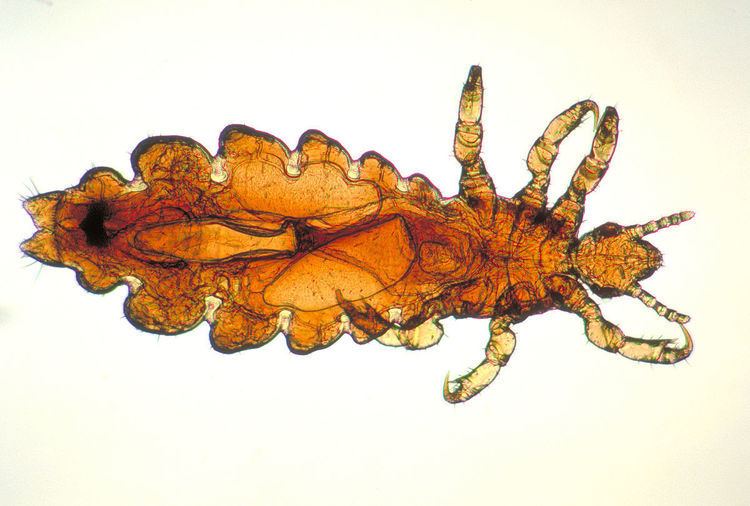Specialty infectious disease ICD-9-CM 132.0 MedlinePlus 000840 | ICD-10 B85.0 DiseasesDB 9725 eMedicine med/1769 | |
 | ||
Pediculosis is an infestation of lice (blood-feeding ectoparasitic insects of the order Phthiraptera). The condition can occur in almost any species of warm-blooded animal (i.e. mammals and birds), including humans. Although pediculosis in humans may properly refer to lice infestation of any part of the body, the term is sometimes used loosely to refer to pediculosis capitis, the infestation of the human head with the specific head louse.
Contents
Classification
Pediculosis may be divided into the following types:
Presentation
Head-lice infestation is most frequent on children aged 3–10 and their families. Approximately 3% of school children in the United States contract head lice. Females are more frequently infested than males. Those of African descent rarely suffer infestation due to differences in hair texture.
Head lice are spread through direct head-to-head contact with an infested person. From each egg or "nit" may hatch one nymph that will grow and develop to the adult louse. Lice feed on blood once or more often each day by piercing the skin with their tiny needle-like mouthparts. While feeding they excrete saliva, which irritates the skin and causes itching. Lice cannot burrow into the skin.
Diagnosis
To diagnose infestation, the entire scalp should be combed thoroughly with a louse comb and the teeth of the comb should be examined for the presence of living lice after each time the comb passes through the hair. The use of a louse comb is the most effective way to detect living lice.
The most characteristic symptom of infestation is pruritus (itching) on the head which normally intensifies 3 to 4 weeks after the initial infestation. The bite reaction is very mild and it can be rarely seen between the hairs. Excessive scratching of the infested areas can cause sores, which may become infected.
Treatment
The number of diagnosed cases of human louse infestations (or pediculosis) has increased worldwide since the mid-1960s, reaching hundreds of millions annually. There is no product or method which assures 100% destruction of the eggs and hatched lice after a single treatment. However, there are a number of treatment methods that can be employed with varying degrees of success. These methods include chemical treatments, natural products, combs, shaving, hot air, silicone-based lotions, and ethanol (ethyl alcohol). The pharmacological treatment of pediculosis include the use of crotamiton applied twice at 24 hour interval and washed off day after that. Benzyl benzoate also can be used when combined with lindane, it is applied once and then washed off after 24 hours.
Epidemiology
About 14 million people, mainly children, are treated annually for head lice in the United States alone. Only a small proportion of those treated, however, may have objective evidence of an extant infestation. High levels of louse infestations have also been reported from all over the world including Denmark, Sweden, U.K., France and Australia. Normally head lice infest a new host only by close contact between individuals, making social contacts among children and parent child interactions more likely routes of infestation than shared combs, brushes, towels, clothing, beds or closets. Head-to-head contact is by far the most common route of lice transmission.
The United Kingdom's National Health Service, and many American health agencies, report that lice "prefer" clean hair, because it's easier to attach eggs and to cling to the strands.
Head lice (Pediculus humanus capitis) are not known to be vectors of diseases, unlike body lice (Pediculus humanus humanus), which are known vectors of epidemic or louse-borne typhus (Rickettsia prowazekii), trench fever (Rochalimaea quintana) and louse-borne relapsing fever (Borrelia recurrentis).
Body lice
This condition, is caused by body louse (Pediculus humanus humanus, sometimes called Pediculus humanus corporis) is a louse which infests humans and is adapted to lay eggs in clothing, rather than at the base of hairs, and is thus of recent evolutionary origin. Pediculosis is a more serious threat due to possible contagion of diseases such as typhus. Epidemiology and treatment of human body lice is described in the article on body lice.
Pubic lice
The pubic or crab louse (Pthirus pubis) is a parasitic insect which spends its entire life on human hair and feeds exclusively on blood. Humans are the only known host of this parasite, although it is more closely related to the louse parasites in other primate species, than are human head or body lice which probably evolved from it as the "original" louse infestation of humans. Epidemiology and treatment of pubic lice is discussed in the article on pubic lice.
Other animals
Pediculosis is more common in cattle than any other type of domesticated animal. This is a significant problem, as it can cause weight loss of 55 to 75 pounds per animal. Some species of lice infesting cattle include the cattle biting louse (Bovicola bovis), the shortnosed cattle louse (Haematopinus eurysternus), the longnosed cattle louse (Linognathus vituli), and the little blue cattle louse (Solenopotes capillatus).
Treatment
Cattle infested with bovine pediculosis are generally treated chemically, by drugs like ivermectin and cypermethrin.
History
In the 15th century, topical mercury treatment was used to treat pediculosis.
